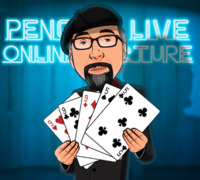
 A lecture from a worker for workers
Report this review
A lecture from a worker for workers
Report this review
Pro Privacy ON
(login to see reviewer names)
on July 27th, 2013
Geoff Williams gave an incredible 3-hour lecture.
There was a wonderful mix of theory and method. Some of the highlights for me, away from the effects, included his talks on adding comedy to your routine, asking “What if?” to raise the level of your magic and thoughts on mind-mapping. These exercises will help you perform what you already have in a better and more entertaining way, and they might also lead you to create an effect.
As for the effects, I loved his Devastation. This has the look and feel of an ACAAN effect, and it is really simple, which will allow you to spend time on your presentation. You can do this with a borrowed deck if you wanted. Spectator shuffles cards, cuts into any number of piles, mentally thinks of one card in one of the piles and remembers the position it is at. The packets are reassembled in a haphazard order with the mentally thought of card buried somewhere in the middle. Then the spectator cuts the deck some more. The performer asks the spectator what his number was. He counts down that many, turns over the card, and it is a match. This blew me away, and when you see the ease in which it is executed, you will be kicking yourself for not thinking of this yourself.
Geoff opened his lecture with his I Hate David Copperfield trick. This is an amazing piece of magic using three cards. I think because of the nature of this trick, you will only want to do this in close settings, maybe one to four people. What ends up happening is a card visually moves from the bottom of the packet to the middle. When I watched this performed on the video, I thought I saw something (as in tipping the method), however, I was wrong. It appeared as if he put it on the bottom slid it out and then slid it back in the middle. I was thinking to myself, what’s the big deal with that. However, when he explained the effect, Geoff demonstrated that he did not accomplish the result with what I thought I saw. So, I think it will be better with a smaller group so they can focus like a laser on the cards and see the odd card is clearly on the bottom when the moving and melting begin. This is very visual, and when the card melts through during the second phase, it is a stunning moment.
For those of you who like Dan Harlan’s Impromptu Linking Rubberband effect, Geoff will show you a way to get into it that is pure gold. The unlink is very good, too.
Geoff combines the Chicago Opener/Red Hot Momma with a Torn and Restored Signed Card. If you have shied away from torn and restored card effects because of having to introduce extra things only to have to ditch them, this could potentially be a solution for you. I am enamored with this plot, and while I practice a different version of this a lot, I have never actually performed it live. I am thinking this is a version I could perform live. Geoff also shares some neat insights into why he combines the torn and restored with the Chicago Opener, and it is something I never considered before.
While there was much more on the lecture, let me close with my thoughts on his Progressive Betting Routine. This is where Geoff continues to up the ante with betting on whether the spectator who free places a face up card in the deck will match or not match the color of the card next to it. Except for his lucky penny that Geoff is willing to wager, the rest of the money comes from a second spectator. I did not care for the betting aspect, as I do not gamble, and I did not care for using someone else’s money (I never like to place a spectator in an awkward position, though this could be taken care of by asking someone before the show to play along, because this does not affect the outcome of the piece, this is not really “pre-show”), however, I really enjoyed the effect. Because it involves matching colors, I saw it as a color effect more so than a betting effect. Because it uses a portion of the deck (slightly less than half), I thought I would combine it with Jon Armstrong’s Out of This Blah effect, which is a take on Paul Curry’s Out of This World using a packet instead of a full deck. Wanting to do things in three (a la Dan Harlan’s Triple Trilogy structure), I sought some advice on The Magic Cafe, and one of the members there suggested completing the routine using Armstrong’s Follow the Leader.
There’s a lot of good, usable effects that you can and will use in Geoff Williams’ three-hour lecture. Host Dan Harlan, who always does a fantastic job and adds so much, noted at the end that there was not much to ask because Geoff had covered and explained so much along the way.
If I might sidestep a little bit, Dan Harlan is a great host. Not only does he ask relevant questions, but he always shares some insights that adds to the understanding or gives pointers on how to take something in a different direction using the methods. His contributions are invaluable and it is almost like getting a free mini-lecture with every Penguin LIVE event in which Harlan is the host. And, Harlan does not interject himself in such a way that it becomes “his show;” he allows the magicians to shine and adds just a little something extra.
I found this lecture to be very worthwhile.
There was a wonderful mix of theory and method. Some of the highlights for me, away from the effects, included his talks on adding comedy to your routine, asking “What if?” to raise the level of your magic and thoughts on mind-mapping. These exercises will help you perform what you already have in a better and more entertaining way, and they might also lead you to create an effect.
As for the effects, I loved his Devastation. This has the look and feel of an ACAAN effect, and it is really simple, which will allow you to spend time on your presentation. You can do this with a borrowed deck if you wanted. Spectator shuffles cards, cuts into any number of piles, mentally thinks of one card in one of the piles and remembers the position it is at. The packets are reassembled in a haphazard order with the mentally thought of card buried somewhere in the middle. Then the spectator cuts the deck some more. The performer asks the spectator what his number was. He counts down that many, turns over the card, and it is a match. This blew me away, and when you see the ease in which it is executed, you will be kicking yourself for not thinking of this yourself.
Geoff opened his lecture with his I Hate David Copperfield trick. This is an amazing piece of magic using three cards. I think because of the nature of this trick, you will only want to do this in close settings, maybe one to four people. What ends up happening is a card visually moves from the bottom of the packet to the middle. When I watched this performed on the video, I thought I saw something (as in tipping the method), however, I was wrong. It appeared as if he put it on the bottom slid it out and then slid it back in the middle. I was thinking to myself, what’s the big deal with that. However, when he explained the effect, Geoff demonstrated that he did not accomplish the result with what I thought I saw. So, I think it will be better with a smaller group so they can focus like a laser on the cards and see the odd card is clearly on the bottom when the moving and melting begin. This is very visual, and when the card melts through during the second phase, it is a stunning moment.
For those of you who like Dan Harlan’s Impromptu Linking Rubberband effect, Geoff will show you a way to get into it that is pure gold. The unlink is very good, too.
Geoff combines the Chicago Opener/Red Hot Momma with a Torn and Restored Signed Card. If you have shied away from torn and restored card effects because of having to introduce extra things only to have to ditch them, this could potentially be a solution for you. I am enamored with this plot, and while I practice a different version of this a lot, I have never actually performed it live. I am thinking this is a version I could perform live. Geoff also shares some neat insights into why he combines the torn and restored with the Chicago Opener, and it is something I never considered before.
While there was much more on the lecture, let me close with my thoughts on his Progressive Betting Routine. This is where Geoff continues to up the ante with betting on whether the spectator who free places a face up card in the deck will match or not match the color of the card next to it. Except for his lucky penny that Geoff is willing to wager, the rest of the money comes from a second spectator. I did not care for the betting aspect, as I do not gamble, and I did not care for using someone else’s money (I never like to place a spectator in an awkward position, though this could be taken care of by asking someone before the show to play along, because this does not affect the outcome of the piece, this is not really “pre-show”), however, I really enjoyed the effect. Because it involves matching colors, I saw it as a color effect more so than a betting effect. Because it uses a portion of the deck (slightly less than half), I thought I would combine it with Jon Armstrong’s Out of This Blah effect, which is a take on Paul Curry’s Out of This World using a packet instead of a full deck. Wanting to do things in three (a la Dan Harlan’s Triple Trilogy structure), I sought some advice on The Magic Cafe, and one of the members there suggested completing the routine using Armstrong’s Follow the Leader.
There’s a lot of good, usable effects that you can and will use in Geoff Williams’ three-hour lecture. Host Dan Harlan, who always does a fantastic job and adds so much, noted at the end that there was not much to ask because Geoff had covered and explained so much along the way.
If I might sidestep a little bit, Dan Harlan is a great host. Not only does he ask relevant questions, but he always shares some insights that adds to the understanding or gives pointers on how to take something in a different direction using the methods. His contributions are invaluable and it is almost like getting a free mini-lecture with every Penguin LIVE event in which Harlan is the host. And, Harlan does not interject himself in such a way that it becomes “his show;” he allows the magicians to shine and adds just a little something extra.
I found this lecture to be very worthwhile.
Add a comment
OPEN BOX
$19.54 (21% OFF)
59
Bestsellers
See all bestsellers
COOL BOX
16% now claimed
1
6
:
2
9
:
1
1
remaining

Act Builder beta




























